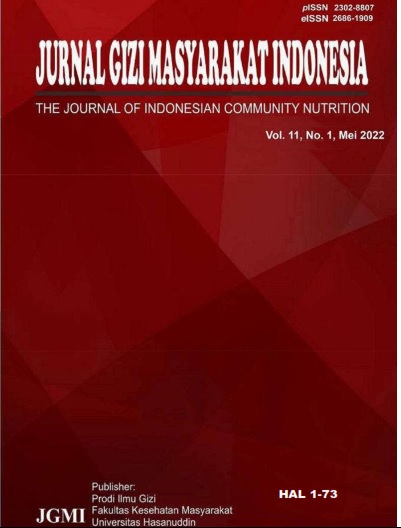RISK FACTORS ASSOCIATED WITH CHRONIC ENERGY DEFICIENCY (CED) IN PREGNANT WOMEN IN THE WORK AREA OF SUDIANG RAYA PUBLIC HEALTH CENTER MAKASSAR CITY
DOI:
https://doi.org/10.30597/jgmi.v11i1.20843Abstract
Introduction: The risk of chronic energy deficiency (CED) during pregnancy has side effects for both mother and fetus. This can lead to anemia and other complications in the mother, as well as risks and complications to the fetus, including bleeding and infection. Aim: This study aims to determine the risk factors associated with the incidence of chronic energy deficiency (CED) in pregnant women in the working area of the Sudiang Raya Public Health Center Makassar City. Methods: This type of research uses quantitative methods with a Cross Sectional Study approach. The sam ple in this study was 67 pregnant women who came to visit the Sudiang Raya Health Center Makassar City in August 2021 using the Simple Random Sampling technique. The research instrument used a questionnaire, LiLA tape measuring instrument, smartphone, and stationery. Data analysis used Chi-Square test. Results: Respondents in the group of pregnant women who were the highest aged from 30-34 years old were 44.8%, and the lowest was >34 years old by 1.5% of the 67 samples who experienced SEZ (58.2%). The results of statistical tests showed that occupation (p-value 0.016) and income (p-value 0.044) had a significant relationship with the incidence of chronic energy deficiency, while parity (p-value 0.757) did not have a significant relationship with the incidence of chronic energy deficiency. chronic energy. Conclusion: The conclusion in this study is that there is a relationship between work and income with the incidence of chronic energy deficiency.
Keywords : Chronic Energy Deficiency, Parity, Employment, Income
Downloads
Published
How to Cite
Issue
Section
License

This work is licensed under a Creative Commons Attribution-NonCommercial-ShareAlike 4.0 International License.




